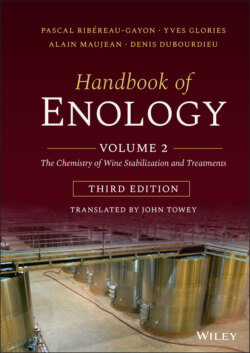Читать книгу Handbook of Enology, Volume 2 - Pascal Ribéreau-Gayon - Страница 12
ОглавлениеREMARKS CONCERNING THE EXPRESSION OF CERTAIN PARAMETERS OF MUST AND WINE COMPOSITION
Units
Metric system units of length (m), volume (l), and weight (g) are exclusively used. The conversion of metric units into Imperial units (inches, feet, gallons, pounds, etc.) can be found in the following enological work: Principles and Practices of Winemaking, R.B. Boulton, V.L. Singleton, L.F. Bisson, and R.E. Kunkee, 1995, The Chapman & Hall Enology Library, New York.
Expression of Total Acidity and Volatile Acidity
Although EU regulations recommend the expression of total acidity in the equivalent weight of tartaric acid, the French custom is to give this expression in the equivalent weight of sulfuric acid. The more correct expression in milliequivalents per liter has not come into widespread use. In this work, we have generally expressed acid levels as sulfuric acid, but in certain cases, the corresponding weight in tartaric acid, often used in other countries, has been given.
Using the weight of the milliequivalent of various acids, the table below can be used to convert from one expression to another.
Coefficients of conversion from one expression of total or volatile acidity to another.
| Known expression | Desired expression | |||
|---|---|---|---|---|
| mEq/l | g/l H2SO4 | g/l tartaric acid | g/l acetic acid | |
| mEq/l | 1.00 | 0.049 | 0.075 | 0.060 |
| g/l H2SO4 | 20.40 | 1.00 | 1.53 | 1.22 |
| g/l tartaric acid | 13.33 | 0.65 | 1.00 | |
| g/l acetic acid | 16.67 | 0.82 | 1.00 |
More particularly, to convert from total acidity expressed in H2SO4 to its expression in tartaric acid, add half of the value to the original value:
In the other direction, a third of the value must be subtracted.
The French also continues to express volatile acidity in equivalent weight of sulfuric acid. More generally, in other countries, volatile acidity is expressed as acetic acid. It is rarely expressed in milliequivalents per liter. The table above also allows simple conversion from one expression to another.
The expression of volatile acidity as acetic acid is approximately 20% higher than as sulfuric acid.
Evaluating the Sugar Concentration of Musts
This measurement is important for tracking grape ripening, monitoring fermentation kinetics and, if necessary, determining the need for chaptalization.
This measurement is always determined by physical, densimetric, or refractometric analysis. The expression of the results can be given according to several scales: some are rarely used today (Baumé scale and Oechsle scale). At present, two systems exist (Volume 1, Section 10.4.3):
1 The potential ethanol content (PEC) of musts can be read directly on equipment that is graduated using a scale corresponding to 17.5 or 17 g/l of sugar for 1% vol. of alcohol. Today, the EU recommends using 16.83 g/l as the conversion factor. The mustimeter is a hydrometer containing two graduated scales: one shows specific gravity and the other gives a direct reading of the PEC. Different methods varying in precision exist to calculate the PEC from a specific gravity reading. These methods take various elements of must composition into account (Boulton et al., 1995).
2 Degrees Brix express the percentage of sugar by weight. By multiplying degrees Brix by 10, the weight of sugar in 1 kg (or slightly less than 1 l) of must is obtained. A conversion table between degrees Brix and PEC is shown in Volume 1, Section 10.4.3. Seventeen (17) degrees Brix corresponds to an approximate PEC of 10%, and 20° Brix corresponds to a PEC of about 12%. Within the alcohol range most relevant to enology, degree Brix can be multiplied by 10 and then divided by 17 to obtain a fairly good approximation of the PEC.
In any case, the determination of the Brix or PEC of a must is approximate. First of all, it is not always possible to obtain a representative grape or must sample for analysis. Secondly, although physical, densimetric, or refractometric measurements are extremely precise and rigorously express the sugar concentration of a sugar and water mixture, these measurements are affected by other substances released into the sample from the grape and other sources. Furthermore, the concentrations of these substances are different for every grape or must sample. Finally, the conversion rate of sugar into alcohol (approximately 17–18 g/l per 1% alcohol by vol.) varies and depends on fermentation conditions and yeast properties. The widespread use of selected yeast strains has lowered the sugar conversion rate.
Measurements Using Visible and Ultraviolet Spectrometry
The measurement of optical density (or absorbance) is widely used to determine wine color (Volume 2, Section 6.4.5) and total phenolic compounds (Volume 2, Section 6.4.1). In these works, optical density is noted as OD, OD 420 (yellow), OD 520 (red), OD 620 (blue), or OD 280 (absorption in ultraviolet spectrum) to indicate the optical density at the indicated wavelengths.
Wine color intensity is expressed as CI = OD420 + OD 520 + OD 620, or is sometimes expressed in a more simplified form: CI = OD 420 + OD 520.
Hue is expressed as
The total phenolic concentration is expressed by OD 280.
The analytical methods are described in Chapter 6 of Volume 2.
